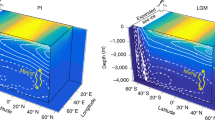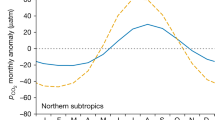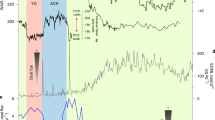Abstract
Rapid climate warming and sea-ice loss have induced major changes in the sea surface partial pressure of CO2 (\(p_{{\mathrm {CO}}_2}\)). However, the long-term trends in the western Arctic Ocean are unknown. Here we show that in 1994–2017, summer \(p_{{\mathrm {CO}}_2}\) in the Canada Basin increased at twice the rate of atmospheric increase. Warming and ice loss in the basin have strengthened the \(p_{{\mathrm {CO}}_2}\) seasonal amplitude, resulting in the rapid decadal increase. Consequently, the summer air–sea CO2 gradient has reduced rapidly, and may become near zero within two decades. In contrast, there was no significant \(p_{{\mathrm {CO}}_2}\) increase on the Chukchi Shelf, where strong and increasing biological uptake has held \(p_{{\mathrm {CO}}_2}\) low, and thus the CO2 sink has increased and may increase further due to the atmospheric CO2 increase. Our findings elucidate the contrasting physical and biological drivers controlling sea surface \(p_{{\mathrm {CO}}_2}\) variations and trends in response to climate change in the Arctic Ocean.
This is a preview of subscription content, access via your institution
Access options
Access Nature and 54 other Nature Portfolio journals
Get Nature+, our best-value online-access subscription
$29.99 / 30 days
cancel any time
Subscribe to this journal
Receive 12 print issues and online access
$209.00 per year
only $17.42 per issue
Buy this article
- Purchase on Springer Link
- Instant access to full article PDF
Prices may be subject to local taxes which are calculated during checkout





Similar content being viewed by others
Data availability
Source Data for Extended Data Fig. 5 are provided with the paper. All the data are archived in publicly accessible databases, and the data sources are listed in the main text, Methods and Supplementary Information. The assembled \(p_{{\mathrm {CO}}_2}\) dataset used in this study is available in the Supplementary Information.
Code availability
The code used for \(p_{{\mathrm {CO}}_2}\) simulations is available in the Supplementary Information. R programming software was used to generate all the results. The saved simulation results are available on request from the corresponding author.
References
Onarheim, I. H., Eldevik, T., Smedsrud, L. H. & Stroeve, J. C. Seasonal and regional manifestation of Arctic sea ice loss. J. Climate 31, 4917–4932 (2018).
Stroeve, J. & Notz, D. Changing state of Arctic sea ice across all seasons. Environ. Res. Lett. 13, 103001 (2018).
Giles, K. A., Laxon, S. W., Ridout, A. L., Wingham, D. J. & Bacon, S. Western Arctic Ocean freshwater storage increased by wind-driven spin-up of the Beaufort Gyre. Nat. Geosci. 5, 194–197 (2012).
Yamamoto-Kawai, M. et al. Surface freshening of the Canada Basin, 2003-2007: river runoff versus sea ice meltwater. J. Geophys. Res. Oceans 114, C00A05 (2009).
Timmermans, M.-L. et al. Mechanisms of Pacific summer water variability in the Arctic’s central Canada Basin. J. Geophys. Res. Oceans 119, 7523–7548 (2014).
Corlett, W. B. & Pickart, R. S. The Chukchi slope current. Prog. Oceanogr. 153, 50–65 (2017).
Stabeno, P., Kachel, N., Ladd, C. & Woodgate, R. Flow patterns in the Eastern Chukchi Sea: 2010–2015. J. Geophys. Res. Oceans 123, 1177–1195 (2018).
Arrigo, K. R. & van Dijken, G. L. Continued increases in Arctic Ocean primary production. Prog. Oceanogr. 136, 60–70 (2015).
Yamamoto-Kawai, M., McLaughlin, F. A., Carmack, E. C., Nishino, S. & Shimada, K. Aragonite undersaturation in the Arctic Ocean: effects of ocean acidification and sea ice melt. Science 326, 1098–1100 (2009).
Qi, D. et al. Increase in acidifying water in the western Arctic Ocean. Nat. Clim. Change 7, 195–201 (2017).
Robbins, L. L. et al. Baseline monitoring of the western Arctic Ocean estimates 20% of Canadian Basin surface waters are undersaturated with respect to aragonite. PLoS ONE 8, e73796 (2013).
Anderson, L. G. et al. Export of calcium carbonate corrosive waters from the East Siberian Sea. Biogeosciences 14, 1811–1823 (2017).
Coupel, P. et al. The impact of freshening on phytoplankton production in the Pacific Arctic Ocean. Prog. Oceanogr. 131, 113–125 (2015).
Nishino, S. et al. Enhancement/reduction of biological pump depends on ocean circulation in the sea ice reduction regions of the Arctic Ocean. J. Oceanogr. 67, 305–314 (2011).
Cai, W.-J. et al. Decrease in the CO2 uptake capacity in an ice-free Arctic Ocean basin. Science 329, 556–559 (2010).
Takahashi, T. et al. Climatological mean and decadal change in surface ocean \({p_{\rm{CO}}}_{2}\), and net sea–air CO2 flux over the global oceans. Deep Sea Res. 2 56, 554–577 (2009).
Takahashi, T. et al. Climatological distributions of pH, \({p_{\rm{CO}}}_{2}\), total CO2, alkalinity, and CaCO3 saturation in the global surface ocean, and temporal changes at selected locations. Mar. Chem. 164, 95–125 (2014).
Bates, N. R. et al. A time-series view of changing surface ocean chemistry due to ocean uptake of anthropogenic CO2 and ocean acidification. Oceanography 27, 126–141 (2014).
Bates, N. R., Moran, S. B., Hansell, D. A. & Mathis, J. T. An increasing CO2 sink in the Arctic Ocean due to sea-ice loss. Geophys. Res. Lett. 33, 1–7 (2006).
Else, B. G. T. et al. Further observations of a decreasing atmospheric CO2 uptake capacity in the Canada Basin (Arctic Ocean) due to sea ice loss. Geophys. Res. Lett. 40, 1132–1137 (2013).
Woodgate, R. A., Weingartner, T. J. & Lindsay, R. Observed increases in Bering Strait oceanic fluxes from the Pacific to the Arctic from 2001 to 2011 and their impacts on the Arctic Ocean water column. Geophys. Res. Lett. 39, L24603 (2012).
Woodgate, R. A. Increases in the Pacific inflow to the Arctic from 1990 to 2015, and insights into seasonal trends and driving mechanisms from year-round Bering Strait mooring data. Prog. Oceanogr. 160, 124–154 (2018).
Hill, V., Ardyna, M., Lee, S. H. & Varela, D. E. Decadal trends in phytoplankton production in the Pacific Arctic Region from 1950 to 2012. Deep Sea Res. 2 152, 82–94 (2018).
Grebmeier, J. M. et al. Ecosystem characteristics and processes facilitating persistent macrobenthic biomass hotspots and associated benthivory in the Pacific Arctic. Prog. Oceanogr. 136, 92–114 (2015).
Spall, M. A. et al. Transport of Pacific water into the Canada Basin and the formation of the Chukchi slope current. J. Geophys. Res. Oceans 123, 7453–7471 (2018).
Brugler, E. T. et al. Seasonal to interannual variability of the Pacific water boundary current in the Beaufort Sea. Prog. Oceanogr. 127, 1–20 (2014).
Peralta-Ferriz, C. & Woodgate, R. A. Seasonal and interannual variability of pan-Arctic surface mixed layer properties from 1979 to 2012 from hydrographic data, and the dominance of stratification for multiyear mixed layer depth shoaling. Prog. Oceanogr. 134, 19–53 (2015).
Mathis, J. T. et al. Storm-induced upwelling of high \({p_{\rm{CO}}}_{2}\)waters onto the continental shelf of the western Arctic Ocean and implications for carbonate mineral saturation states. Geophys. Res. Lett. 39, L07606 (2012).
Takahashi, T., Olafsson, J., Goddard, J. G., Chipman, D. W. & Sutherland, S. C. Seasonal variation of CO2 and nutrients in the high-latitude surface oceans: a comparative study. Glob. Biogeochem. Cycles 7, 843–878 (1993).
Takahashi, T. et al. Global sea–air CO2 flux based on climatological surface ocean \({p_{\rm{CO}}}_{2}\), and seasonal biological and temperature effects. Deep Sea Res. 2 49, 1601–1622 (2002).
Lovenduski, N. S., Gruber, N., Doney, S. C. & Lima, I. D. Enhanced CO2 outgassing in the Southern Ocean from a positive phase of the Southern Annular Mode. Glob. Biogeochem. Cycles 21, GB2026 (2007).
Landschützer, P., Gruber, N., Bakker, D. C., Stemmler, I. & Six, K. D. Strengthening seasonal marine CO2 variations due to increasing atmospheric CO2. Nat. Clim. Change 8, 146–150 (2018).
Wang, M., Yang, Q., Overland, J. E. & Stabeno, P. Sea-ice cover timing in the Pacific Arctic: the present and projections to mid-century by selected CMIP5 models. Deep Sea Res. 2 152, 22–34 (2018).
Timmermans, M.-L., Ladd, C. & Wood, K. Sea Surface Temperature (Arctic Report Card, NOAA, 2015).
Steele, M. & Dickinson, S. The phenology of Arctic Ocean surface warming. J. Geophys. Res. Oceans 121, 6847–6861 (2016).
Perovich, D. K. & Polashenski, C. Albedo evolution of seasonal Arctic sea ice. Geophys. Res. Lett. 39, L08501 (2012).
DeGrandpre, M. et al. Changes in the Arctic Ocean carbon cycle with diminishing ice cover, Geophys. Res. Lett. Preprint at https://www.essoar.org/doi/10.1002/essoar.10502603.1 (2020).
Bakker et al. A multi-decade record of high quality data in version 3 of the Surface Ocean CO2 Atlas (SOCAT). Earth Syst. Sci. Data 8, 383–413 (2016).
Takahashi, T., Sutherland, S. & Kozyr, A. Global Ocean Surface Water Partial Pressure of CO 2 Database: Measurements Performed During 1957–2017 (LDEO Database Version 2017) (NCEI Accession 0160492) (National Oceanic and Atmospheric Administration, Department of Commerce, accessed 28 August, 2018).
Pierrot, D. et al. Recommendations for autonomous underway measuring systems and data-reduction routines. Deep Sea Res. 2 56, 512–522 (2009).
Pierrot, D., Lewis, E. & Wallace, D. W. R. MS Excel program developed for CO2 system calculations. ORNL/CDIAC-105a. v2.1(Carbon Dioxide Information Analysis Center, Oak Ridge National Laboratory, U.S. Department of Energy, 2006).
Lueker, T. J., Dickson, A. G. & Keeling, C. D. Ocean \({{\rm{p}}_{\rm{CO}}}_{2}\) calculated from dissolved inorganic carbon, alkalinity, and equations for K1 and K2: validation based on laboratory measurements of CO2 in gas and seawater at equilibrium. Mar. Chem. 70, 105–119 (2000).
Woosley, R. J., Millero, F. J. & Takahashi, T. Internal consistency of the inorganic carbon system in the Arctic Ocean. Limnol. Oceanogr. Methods 15, 887–896 (2017).
Sarmiento, J. L., & Gruber, N. Ocean Biogeochemical Dynamics (Princeton Univ. Press, 2006).
Olsen, A. et al. GLODAPv2.2019—an update of GLODAPv2. Earth Syst. Sci. Data 11, 1437–1461 (2019).
Friis, K., Körtzinger, A. & Wallace, D. W. The salinity normalization of marine inorganic carbon chemistry data. Geophys. Res. Lett. 30, 1085 (2003).
Rysgaard, S., Glud, R. N., Sejr, M. K., Bendtsen, J. & Christensen, P. B. Inorganic carbon transport during sea ice growth and decay: a carbon pump in polar seas. J. Geophys. Res. Oceans 112, C03016 (2007).
Ji, B. Y. et al. Variations in rates of biological production in the Beaufort Gyre as the Arctic changes: rates from 2011 to 2016. J. Geophys. Res. Oceans 124, 3628–3644 (2019).
Weiss, R. Carbon dioxide in water and seawater: the solubility of a non-ideal gas. Mar. Chem. 2, 203–215 (1974).
Wanninkhof, R. Relationship between wind speed and gas exchange over the ocean revisited. Limnol. Oceanogr. Methods 12, 351–362 (2014).
Comiso, J. C. Bootstrap Sea Ice Concentrations from Nimbus-7 SMMR and DMSP SSM/I-SSMIS v.2 (NASA National Snow and Ice Data Center Distributed Active Archive Center, accessed 21 August, 2018).
Buck, A. L. New equations for computing vapor pressure and enhancement factor. J. Appl. Meteorol. 20, 1527–1532 (1981).
Fetterer, F., Knowles, K., Meier, W. N., Savoie, M. & Windnagel, A. K. Sea Ice Index v.3 (National Snow and Ice Data Center, accessed 10 November, 2018).
Acknowledgements
We thank the contributors to the SOCAT v.5, LDEO, CHINARE, JAMSTEC, USGS, NSF Arctic Data Center and CDIAC datasets, as well as the research vessels and crews for collecting the data used in this study. We thank H. Wang for helpful discussion. This work was supported by the US NSF (grant nos ARC-0909330, PLR-1304337, OPP-1926158, PLR-1220032, PLR‐1504410, OPP−1735862 and PLR‐1723308), NOAA (grant nos NA09OAR4310078, NA150OAR4320064 and NA10NOS4000073), Interdisciplinary Research for Arctic Coastal Environments funded by US Deparment of Energy (DOE InteRFACE project), the National Natural Science Foundation of China (grant nos 41806222, 41630969, 41230529, 41476172 and 41706211), the Chinese Projects for Investigations and Assessments of the Arctic and Antarctic (grant no. CHINARE2017-2020), the National Key Research and Development Program of China (grant no. 2019YFA0607003), the Scientific Research Foundation of Third Institute of Oceanography, SOA (grant nos 2018005 and 2017029), the Bilateral Cooperation of Maritime Affairs (grant no. 2200207), Fujian science and technology innovation leader project 2016, and the Arctic Challenge for Sustainability (ArCS) Project funded by the Ministry of Education, Culture, Sports, Science and Technology of Japan (MEXT).
Author information
Authors and Affiliations
Contributions
L.C. and W-J.C. organized the collaborative research on the Arctic Ocean Carbon Cycle and Acidification Project via CHINARE cruises. Z.O., W-J.C. and T.T. prepared the paper. Z.O., D.Q., B.C., Z.G. and H.S. executed the fieldwork. Z.O., W.Z., D.Q. and B.C. analysed the data. Z.O. did the model simulations. T.T., M.D.D., A.M., S.N., M.J. and L.L.R. contributed the data and materials. All authors contributed to the discussion and writing.
Corresponding author
Ethics declarations
Competing interests
The authors declare no competing interests.
Additional information
Publisher’s note Springer Nature remains neutral with regard to jurisdictional claims in published maps and institutional affiliations.
Extended data
Extended Data Fig. 1 The distribution of sea surface pCO2 at in situ temperature in the western Arctic Ocean.
All pCO2 data was measured by underway pCO2 systems except datasets in AOS1994, JOIS 1997, SHEBA 1998 and ODEN 2005 cruises, which were calculated from discrete samples. MR, NP, ODEN, XL, ML, PS, HY, RO, St. L, and Sikuliaq stand for the Research Vessel Mirai, Nathaniel B. Palmer, ODEN, Xuelong, Marcus G. Langseth, Polarstern, Healy, Ronald H. Brown, Louis S. St-Laurent, and Sikuliaq, respectively. A list of cruise information is provided in Supplementary Table 1. The white areas with dashed lines indicate monthly sea ice extent (ice concentration >15%) in September, which has the minimal sea ice extent (Nation Snow and Ice Data Center, http://nsidc.org/data/seaice_index/)53.
Extended Data Fig. 2 Monthly time series of the number of sea surface pCO2 measurements in the western Arctic Ocean.
(a) Canada Basin, (b) Chukchi Shelf, (c) Beaufort Sea, (d) Ice-covered region (north of 80ºN). For a given subregion, the number of pCO2 observations for each month could vary greatly among years depending on the number and timing of cruises, and the sea-ice conditions in a particular year. The number of pCO2 values substantially increased after 2007.
Extended Data Fig. 3 The changes in the seasonality of pCO2 and deseasonalized long-term trends.
We examined the seasonal variation of pCO2 by binning gridded (0.1° latitude × 0.25° longitude) values into Julian-Day for two periods: years prior to 2007 (a–d) and 2007 to 2017 (e-h). We deseasonalized data to calculate monthly means of pCO2 following the method described in ref. 16. Briefly, we detrended pCO2 data first and then adjusted the monthly means by adding or subducting the anomaly with respect to the long-term summer mean (averaged over 1994-2017), assuming that the seasonal variations remained unchanged over years. The black and blue dots represent non- and seasonal adjusted monthly means of pCO2, respectively (i–l). The rates of change with standard error are noted.
Extended Data Fig. 4 The trends of CO2 air-sea gradient (∆pCO2).
The summer ∆pCO2 vary in the Chukchi Shelf, the Canada Basin, the Beaufort Sea and ice-covered region over the period of 1994 to 2017. The rates of change of ∆pCO2 were computed with monthly mean values (positive rates indicate decrease in ∆pCO2, while negative rates indicate increase in ∆pCO2). The dashed line indicates a complete air-sea gas equilibrium. ANOVA was performed for all regressions. Only ∆pCO2 in the Canada Basin shows a significant trend.
Extended Data Fig. 5 The long-term trends of sea surface sAlk, sDIC, Salinity, and Revelle Factor in the Canada Basin.
The discrete samples of sea surface (depth < 20 m) Alk and DIC were obtained from the Global Data Analysis Project version 2 database38 (grey dots). We calculated salinity normalized DIC (sDIC = DIC×S0/SSS) and Alk (sAlk = Alk×S0/SSS) and then averaged the data to calculate monthly means (black dots) for the linear regressions (a and b). The S0 is the reference salinity, i.e. the long-term mean of SSS. We also conducted a non-zero endmember salinity normalization39 for DIC and Alk (d and e; see Methods). The corresponding Revelle Factor was calculated in the CO2SYS program (c and f). The underway measurement of salinity was used for examining the long-term trend (g). We tested whether the slope significantly different from 0 by ANOVA. The rates of change with standard error are shown.
Extended Data Fig. 6 Sea ice-loss amplifying the decrease in surface water Revelle Factor (RF) in the Canada Basin.
Black dots represent the initial condition for RF and DIC at -1.6 °C. The arrows indicate the processes of warming (red), CO2 uptake from the atmosphere (purple), dilution by ice meltwater (cyan). Sea ice reduction from 95% to ice-free is accompanied by a salinity decrease of 3.5 (Supplementary Table 4). The yellow shaded areas indicate the possible seasonal variations of RF, which are amplified by the synergistic effect of ice melt, warming and CO2 uptake. To estimate the change of RF, we allowed 2 °C and 3 °C warming, and 10 and 50 µmol kg−1 DIC perturbations due to air-sea CO2 exchange in 1990s and 2010s, respectively, which are consistent with the long-term warming rate of 0.5 °C per decade34 and the estimated increase in sDIC by 2.3-2.6 µmol kg−1 per year (Table 1 and Fig. 4d). Note that higher RF indicates lower acid-base buffer capacity.
Supplementary information
Supplementary Information
Supplementary Figs. 1–5, Tables 1–4 and references.
Supplementary Data 1
Assembled \(p_{{\mathrm {CO}}_2}\) dataset (1994–2017) used in this study.
Supplementary Software
The code used for \(p_{{\mathrm {CO}}_2}\) simulations for the Canada Basin.
Supplementary Data 2
The data used for \(p_{{\mathrm {CO}}_2}\) simulations for the Canada Basin.
Source data
Source Data Extended Data Fig. 5
DIC and Alk in the Canada Basin downloaded from GLODAPv2.
Rights and permissions
About this article
Cite this article
Ouyang, Z., Qi, D., Chen, L. et al. Sea-ice loss amplifies summertime decadal CO2 increase in the western Arctic Ocean. Nat. Clim. Chang. 10, 678–684 (2020). https://doi.org/10.1038/s41558-020-0784-2
Received:
Accepted:
Published:
Issue Date:
DOI: https://doi.org/10.1038/s41558-020-0784-2
This article is cited by
-
A dynamic link between spring Arctic sea ice and the Tibetan Plateau snow increment indicator
npj Climate and Atmospheric Science (2023)
-
Arctic Ocean annual high in \({{\boldsymbol{p}}}_{{{\bf{CO}}}_{{\bf{2}}}}\) could shift from winter to summer
Nature (2022)
-
Sea ice loss of the Barents-Kara Sea enhances the winter warming over the Tibetan Plateau
npj Climate and Atmospheric Science (2022)
-
Acceleration of western Arctic sea ice loss linked to the Pacific North American pattern
Nature Communications (2021)
-
Seasonal variability of net sea-air CO2 fluxes in a coastal region of the northern Antarctic Peninsula
Scientific Reports (2020)



